The Mundeck Salt Unit: A Review of Aptian Depositional Context and Hydrocarbon Potential in the Kribi-Campo Sub-Basin (South Cameroon Atlantic Basin)
Abstract
:1. Introduction
- (1)
- The distribution of the salt unit remains a topic of debate. Some authors [37,38,39] argue that salt deposits do not exist in the study area for several reasons. Firstly, they claim that along the SWAM, salt deposits do not extend beyond 1° N latitude. Secondly, they attributed the folds observed in the KCSB offshore area to the reactivation of transfer faults rather than the influence of underlying salt tectonics. This perspective is further supported in [40], which, in delineating the SWAM borders, restricts salt distribution to the region between the Angola and Rio Muni Margins (Figure 2), thereby suggesting the absence of this salt unit in the Cameroon Margin. Conversely, there are geoscientific studies and exploration campaigns [6,9,10,41,42,43], which have recognized the presence of salt deposits in the KCSB. However, debate continues regarding the extent of these deposits. Two main hypotheses exist; one suggests that the salt deposits are localized [19], while the other proposes a broader distribution along the SCAB offshore domain [6,9,14,41]. This ongoing debate highlights the need for further research to clarify the distribution and extent of the salt unit.
- (2)
- Regarding the depositional context, there is a notable division among researchers. One group [19,42,44,45] suggests that salt deposition occurred during the syn-rift phase, proposing that the salt is lacustrine in origin. The second group [14,41], on the other hand, argues that this event took place during the transitional or post-rift stages, indicating a marine type of salt. This divergence in viewpoints underscores the complexity of the basin’s geological history, making it challenging to pinpoint the precise timing and environmental conditions of salt formation in the KCSB.
- (3)
- The hydrocarbon potential of the KCSB warrants a thorough reassessment. The results obtained from ExxonMobil’s drilling campaign in offshore Kribi revealed a lack of petroleum associated with the identified salt diapir. The finding contrasts to recent studies of similar salt units [12], such as the Ezanga Salt in Gabon and the Rio Muni Salt in Equatorial Guinea, which have demonstrated promising hydrocarbon potential. Notably, the base of the salt diaper was not reached during the ExxonMobil campaign, leaving the possibility of untapped resources at deeper levels.
2. Geological Setting
2.1. Overview of SWAM Salt Basins
- (1)
- The coastal basins of Cameroon, specifically the Douala and Kribi-Campo sub-basins, along with the Rio Muni Basin in Equatorial Guinea, are regarded as the African counterparts of the Sergipe-Alagoas Basin in northeastern Brazil. Comparing these basins in Africa and Brazil highlights their geological similarities and differences. Some works [43,46] have shown that the salt units found in these regions (Kribi salt and Rio Muni salt) formed during the syn-rift phase. With a thickness up to 800 m, these salt units are interbedded with lacustrine shales, representing the second term of the syn-rift sequence [3]. This observation suggests that the salts in the KCSB and Rio-Muni Basin are of lacustrine origin. Lacustrine salts typically form in restricted, evaporitic settings where periodic changes in water chemistry and climate conditions lead to the precipitation of salts [19,43,45].
- (2)
- In Gabon, the saliferous sedimentation is represented in the onshore parts of the Interior, North, and South Gabon sub-basins by the Ezanga Formation. The Ezanga Salt is predominantly composed of halite, and occurred during Aptian time (post-rift stage) [3,43]. Typically, the deposition of halite indicates periods of restricted marine environments characterized by high evaporation rates. Estimating the true thickness of this salt is challenging because of the extensive salt deformation, however it is known that its thickness reaches approximately 1000 m in the offshore part of the Gabon Basin [3].
- (3)
- In the Cabinda and Lower Congo basins, evaporites known as the Loeme Salt were deposited during the late Aptian, primarily consisting of halite and minor anhydrite. These deposits exhibit varying thicknesses ranging from 800 m to 1000 m [3]. This extensive evaporitic stage ended with the deposition of approximately 50 m of dolomites [43]. These observations indicate that the Loeme Salt of marine origin [3] was deposited during the post-rift stage, like the Ezanga Salt in Gabon.
- (4)
- In the Kwanza, Benguela and Moçamedes basins, the salt formations exhibit similarities to the Loeme Salt observed in the Lower Congo. Its deposition occurred in this area during the Aptian–Albian period, as a substantial evaporitic sequence reaching a thickness of approximately 600 m [3,43]. Unlike other regions, the salt deposits in this area consist of halite, anhydrite, and dolomite [3,43]. Similar to the Loeme Salt, the salt deposits in this domain were formed during the post-rift stage, suggesting that they are also of marine origin [3].
2.2. Stratigraphic Descriptions
- The Lower Mundeck Formation
- The Upper Mundeck Formation
2.3. Depositional Environments
2.4. Geodynamic Evolution
- Pre-rift phase (Late Jurassic; Figure 4A): The pre-rift phase is marked by the development of the Afro-Brazilian depression during the Late Jurassic, following the implementation of regional subsidence [19]. The pre-rift mega-sequence consists of continental deposits, including alluvial, fluvial, and lacustrine sediments. However, these deposits have not yet been identified in outcrop within the study area. According to some works [16,41], the pre-rift section, dated to the Late Jurassic [10,12], consists of Precambrian-sourced arkosic sandstones and conglomerates. [3] noted that this section is only observed in the deeper offshore parts of the study area, corroborated by other studies focusing on the offshore part [6,9,10]. These deeper offshore observations highlight the complexity and significant depth of the pre-rift deposits, which have remained largely buried and unexplored in onshore sections.
- Syn-rift phase (Berriasian to early Aptian; Figure 4B): [54] suggests that the history of the South Atlantic Basin during the syn-rift phase is marked by the separation of Africa and South America, which initiated the opening of the South Atlantic Ocean. This tectonic event led to multiple phases of subsidence, resulting in the development of elongated and faulted basins [19]. The primary characteristic of this period is the extensional tectonics that established a structural framework dominated by a submeridian cutting in horsts and grabens. Superimposed on these structures are N60° E faults, which serve as are early indicators of the Atlantic transform faults [38]. This fracturing pattern, controlled by listric faults and associated roll-overs [55], suggests that these features may have been inherited from the underlying Precambrian basement structures. This phase is particularly significant for the deposition of the Lower Mundeck Formation [41], which rests unconformably on the Precambrian basement. In this phase, lacustrine environments developed in low-lying basins where rivers or streams supplied freshwater while simultaneously allowing for the intrusion of seawater during periods of high sea level or tectonic activity.
- Rift-drift phase (early to middle Aptian): The rift-drift phase, spanning the early to middle Aptian, is marked by significant geological activity, including the deposition of salt and the establishment of a series of faults that segmented the rift structure [39]. During this period, the deposition of evaporates, primarily consisting of salt, occurred extensively along the SWAM including the KCSB. This saliferous sedimentation is a key feature of the rift-drift phase, indicative of the unique depositional environments. The formation of salt layers was facilitated by restricted marine conditions, leading to the evaporation of seawater and the subsequent precipitation of evaporite minerals. In the KCSB, the presence of these salt deposits has been reported by borehole data analysis [16,41], which is defined as the Mundeck salt unit in this study.
- Post-rift phase (middle Aptian to recent; Figure 4C,D): The post-rift phase, extending from the middle Aptian to the present, is characterized by the development of structures, likely related to the movement and deformation of salt and gravitational instability along the margin. It led to the reversal of roll-over structures and the formation of complex subsurface features. This period is marked by three stages; the initial drift (Albian–Coniacian) is characterized by the uplift of the margin, inducing a rotation of the tilted blocks and the Senonian angular unconformity. The second drift (Santonian–Eocene) is marked by the inversion of the roll-over structures and the folding of the platform. The final drift (Eocene–Pleistocene) is linked to the last gravity slides induced by the Cenozoic uplift.
3. Data and Methodology
3.1. Data
3.2. Methodology
3.2.1. Borehole Data Analysis
3.2.2. Seismic Data Analysis
4. Results
4.1. Lithological Description and Interpretation
4.2. Seismic Interpretation
4.2.1. Seismic Horizons
- Seismic horizon G is defined by “onlap terminations” at its top as observed on the SS1 profile (Figure 8b). This reflector marks the contact between reflections with a particular character and chaotic reflections arranged in a disordered manner, indicating an unconformity based on fundamental principles listed in methodology section (Figure 8c). The regional geology review suggests that this reflector corresponds to the contact between the Late Jurassic to Barremian strata and the Precambrian basement within the study area (Figure 8). Near the Kribi Margin, its depth varies from 5800 to 7600 m, dipping westward (Figure 8b). This reflector shows three signatures laterally from west to east, which are flats, descending ramp, and ascending ramp (Figure 8b).
- Seismic horizon H is defined by “onlap terminations” at its top and “toplap terminations” at its base across both seismic profiles (Figure 8b and Figure 9b). Based in established principles, this reflector corresponds to a flooding surface (FS), marking the transition between lowstand system tracts (continental deposits) and transgressive system tracts (marine deposits) in the study area (Figure 8c and Figure 9c). Based on a regional geology review, Horizon H corresponds to an early Aptian FS in the study area (Figure 8c and Figure 9c). It overlies the top Precambrian basement (reflector G) on the eastern side of SS1 and SS2 profiles, indicating the influence of a transgressive phase. Near the Kribi Margin (SS1 Profile), its depth varies from 5800 to 7200 m with a westward dip (Figure 8b). Near the Campo Margin (SS2 Profile), its depth ranges from 4000 to 3600 m, dipping eastward (Figure 9b). Like Horizon G, H-reflector shows consistent lateral signatures across both SS1 and SS2 profiles (Figure 8b and Figure 9b).
- Seismic horizon I is defined by “downlap terminations” at its top on both SS1 and SS2 profiles (Figure 8b and Figure 9b). The stratal terminations associated to this surface indicate a “downlap surface (DLS)”, marking the transition between transgressive system tracts and highstand system tracts, within the study area (Figure 8c and Figure 9c). Based on the regional geology, this reflector corresponds to the middle Aptian DLS. Toward the eastern section of each analyzed seismic profile, this surface exhibits significant curvature (Figure 8b and Figure 9b). Near the Kribi Margin (SS1 Profile), its depth varies from 2000 to 5000 m from east to west (Figure 8b). Near the Campo Margin (SS2 Profile), its depth ranges from 2700 to 2200 m in the same direction (Figure 9b). Like the horizon G, on both the SS1 and SS2 profiles, this reflector shows three lateral signatures from west to east, as follows: flats, descending ramp, and ascending ramp (Figure 8b and Figure 9b).
- Seismic horizon J, marked by “erosional truncation terminations” at its base, on both the SS1 and SS2 profiles (Figure 8b and Figure 9b), signifies an unconformity (Figure 8c and Figure 9c). This reflector, which corresponds to the pre-Cenomanian summit, represents the contact between the Lower and Upper Cretaceous deposits (Figure 8b and Figure 9b). Near the Kribi Margin (SS1 Profile), its depth varies from 2200 to 3400 m from east to west (Figure 8b). Near the Campo Margin (SS2 Profile), in contrast, its depth ranges from 1000 to 2200 m westward, with a notable decrease to 400 m at the center of the profile (Figure 9b). Both the SS1 and SS2 profiles display this reflector’s laterally variations, including descending and ascending ramps (Figure 8b and Figure 9b).
4.2.2. Seismic Sequences
- Seismic Sequence SE1
- Seismic Sequence SE2
- Seismic Sequence SE3
5. Discussion
5.1. Salt Distribution
5.2. Depositional Context
5.3. Hydrocarbon Implications
6. Conclusions
- The Mudeck salt unit (Aptian) exists in the KCSB offshore domain and is homologous with the Rio Muni salt in Equatorial Guinea and Ezanga Salt in Gabon;
- The Mudeck salt unit is characterized by two shapes—diapir and pillow;
- The KCSB salt unit is distributed along N–S-trending structures;
- The Cameroon salt unit results from a sea-level drop associated with thermodynamic events, likely originating from MOR activities.
- Similar to its homologues, the KCSB’s salt demonstrates significant potential to serve as an effective seal and to form both stratigraphic and structural hydrocarbon traps.
Author Contributions
Funding
Institutional Review Board Statement
Informed Consent Statement
Data Availability Statement
Acknowledgments
Conflicts of Interest
References
- Knight, R.; Westwood, J. Long-term prospects very bright for deep waters off West Africa. Oil Gas J. 1999, 97, 33–38. [Google Scholar]
- Cameron, N.R.; White, K. Exploration Opportunities in Offshore Deepwater Africa. In Proceedings of the IBC ‘Oil and Gas Developments in West Africa’, London, UK, 25–26 October 1999; p. 28. [Google Scholar]
- Brownfield, M.E.; Charpentier, R. Geology and Total Petroleum Systems of the West-Central Coastal Province (7203), West Africa; 2207-B; USGS: Reston, VA, USA, 2006; p. 52.
- Beglinger, S.E.; Doust, H.; Cloetingh, S. Relating petroleum system and play development to basin evolution: West African South Atlantic basins. Mar. Pet. Geol. 2012, 30, 1–25. [Google Scholar] [CrossRef]
- Coward, M.P.; Purdy, E.G.; Ries, A.C.; Smith, D.G. The Distribution of petroleum reserves in basins of the South Atlantic margins. In The Oil and Gas Habitats of the South Atlantic; Cameron, N.R., Bate, R.H., Clure, V.S., Eds.; Special Pub; GSL: London, UK, 1999; Volume 153, pp. 101–131. [Google Scholar]
- Mbida, Y. Caractérisation par Imagerie Géophysique de la Couverture Sédimentaire des Bassins Offshores Profonds du Nord de la Cyrénaïque et de Douala/Kribi-Campo: Éléments de Géologie Pétrolière. Ph.D. Thesis, University of Yaounde I, Ngoa ekellé, Cameroon, 2012. [Google Scholar]
- Brownfield, M.E. Assessment of Undiscovered Oil and Gas Resources of the West-Central Coastal Province, West Africa; USGS: Reston, VA, USA, 2016; p. 41.
- Lawrence, S.R.; Beach, A.; Jackson, O.; Jackson, A. Deformation of oceanic crust in the eastern Gulf of Guinea: Role in the evolution of the Cameroon Volcanic Line and influence on the petroleum endowment of the Douala-Rio Muni Basin. In Petroleum Geoscience of the West Africa Margin; Sabato Ceraldi, T., Hodgkinson, R.A., Backe, G., Eds.; GSL: London, UK, 2016; p. 438. [Google Scholar] [CrossRef]
- Loule, J.P.; Jifon, F.; Angoua-Biouele, S.E.; Nguema, P.; Spofforth, D.; Carruthers, D.; Watkins, C.; Johnston, J. An opportunity to re-evaluate the petroleum potential of the Douala/Kribi-Campo Basin, Cameroon. Spec. Top. Pet. Geol. 2018, 36, 61–70. [Google Scholar] [CrossRef]
- Mienlam Essi, M.-F.; Yene Atangana, J.Q.; Abate Essi, J.M.; Mbida, Y.; Angoua Biouele, S.E.; Nguema, P.; Tsimi Ntsengue, C. Stratigraphical nature of the Top Albian surface, from seismic and wells data analyses, in the south Sanaga area (Cameroon Atlantic margin): Palaeogeographical significance and petroleum implications. Mar. Pet. Geol. 2021, 129, 105073. [Google Scholar] [CrossRef]
- Iboum Kissaakaa, J.B.; Ngum Tchioben Fonyuy, C.; Fowe Kwetche, P.G.; Ngo Elogan Ntem, J.; Binyet Njebakala, J.; Makosso Tchapi, R.Y.; Mvondo Owono, F.; Ntamak-Nida, M.-J. Tectono-stratigraphic architecture, depositional systems and salt tectonics to strike-slip faulting in Kribi-Campo-Cameroon Atlantic Margin with an unsupervised machine learning approach (West African Margin). Mar. Pet. Geol. 2023, 59, 106667. [Google Scholar] [CrossRef]
- Robertson, C.G.G. Petroleum Geological Evaluation: Niger Delta to the Congo Fan, Report No. AM086. Unpublished Report. 2015.
- Nemcôk, M.; Ryba, S.R.; Sinha, S.T.; Hermeston, S.A.; Ledvenyiova, L. Transform margins: Development, controls and petroleum systems—An introduction. Geol. Soc. Lond. Spec. Publ. 2016, 431, 1–38. [Google Scholar] [CrossRef]
- Essi, M.-F.M.; Atangana, J.Q.Y.; Mbida, Y.; Biouele, S.E.A.; Lee, E.Y. Salt Units of the Kribi-Campo Sub-Basin Revisited, Using Offshore 2D Seismic and Boreholes Data: Depositional Context and Petroleum Implications. Proceedings 2023, 87, 2. [Google Scholar] [CrossRef]
- Le, A.; Huuse, M.; Redfern, J.; Irving, D. Seismic Characterization of a Bottom Simulating Reflector (BSR) and Plumbing System of the Cameroon Margin, West Africa. Mar. Pet. Geol. 2015, 68, 629–647. [Google Scholar] [CrossRef]
- Pauken, R. Sanaga Sud Field, offshore Cameroon, West Africa. In Giant Oil and Gas Field of the Decade 1978–1988; Halbouty, M., Ed.; AAPG: Tulsa, OK, USA, 1992; Volume Memoir 54, pp. 217–230. [Google Scholar] [CrossRef]
- Ntem, J.N.E.; Ntamak-Nida, M.J.; Bisso, D.; Owono, F.M.; Ngos, S., III.; Bilong, P.; Nouck, P.N. Depocenters Repartition and Sequence Stratigraphy of the Northern Part of the Kribi-Campo Sub-Basin (Cameroon). Eur. J. Sci. Res 2018, 149, 258–278. [Google Scholar]
- Secke Bekonga Gouott, B.; Mbida, Y.; Yene Atangana, J.Q.; Nkoa Nkoa, E.P.; Angoua Biouele, S.E.; Niyazi, Y.; Eruteya, O. Seismic geomorphology of a Late Cretaceous submarine channel system on the continental slope of Kribi/Campo sub-basin, offshore Cameroon. Mar. Pet. Geol. 2022; in press. [Google Scholar] [CrossRef]
- SPT/Simon Petroleum and Technology. Petroleum Geology and Hydrocarbon Potential of Douala Basin, Cameroon; Unpublished Non-Exclusive Report; SPT/Simon Petroleum and Technology: Yaounde, Cameroon, 1995; p. 50. [Google Scholar]
- Bray, R.; Lawrence, S.; Angoua Biouele, S.E. New Perspectives—New Plays in the Douala Basin of Cameroon, Republic of Cameroon; Unpublished Internal Report; NHC: Yaounde, Cameroon, 2003; p. 30.
- ECL/Exploration Consultants Limited. Douala/Kribi-Campo Basin-Structure, Source Rock and Hydrocarbons Study.Doc; Unpublished Internal Report NHC; ECL/Exploration Consultants Limited: Yaounde, Cameroon, 2003; p. 200. [Google Scholar]
- Fusion Oil & Gas NL. Wells Summary Sheets of Douala-Kribi-Campo Basin; Unpublished Internal Report NHC; Fusion Oil & Gas NL: Yaounde, Cameroon, 2003; p. 39. [Google Scholar]
- Nguimbous-Kouoh, J.J.; Tchutchoua, J.; Ngos, S., III.; Ndougsa Mbarga, T.; Manguelle-Dicoum, E. Hydrocarbon Potential of Two Coastal Basins (Cameroon). Int. J. Geosci. 2018, 92, 131–147. [Google Scholar] [CrossRef]
- Ntamak-Nida, M.J.; Bourquin, S.; Makong, J.C.; Baudin, F.; Mpesse, J.E.; Itjokonguem, C.; Schnyder, J.; Komguem, P.B.; Abolo, G.M. Sedimentology and sequence stratigraphy from outcrops of the Kribi-Campo sub-basin: Lower Mundeck Formation (Lower Cretaceous, southern Cameroon). J. Afr. Earth Sci. 2010, 18, 1–18. [Google Scholar] [CrossRef]
- Gill, J.; Cameron, D. 3D reviews an old play: An Aptian subsalt discovery, Etame field, offshore Gabon, West Africa. Lead. Edge 2002, 21, 1147–1151. [Google Scholar] [CrossRef]
- Dupre, S.; Bertotti, G.; Cloeting, S. Tectonic history along the South Gabon Basin: Anomalous early post-rift subsidence. Mar. Pet. Geol. 2007, 24, 151–172. [Google Scholar] [CrossRef]
- Makhubele, M.M.H. The Role of Salt Tectonics in the Hydrocarbon Potential of the Post-Salt Deposits (Albian to Recent), Offshore Gabon. Master’s Thesis, University of the Western Cape, Cape Town, South Africa, 1 April 2014. [Google Scholar]
- Versfelt, J.W. South Atlantic Margin Rift Basin Asymmetry and Implications for Pre-Salt Exploration; Search and Discovery Article #30112. In Proceedings of the AAPG International Conference and Exhibition, Rio de Janeiro, Brazil, 15–18 November 2010; p. 34. [Google Scholar]
- Jameson, M.; Wells, S.; Greenhalgh, J.; Borsato, R. Prospectivity and seismic expressions of pre- and post-salt plays along the conjugate margins of Brazil, Angola and Gabon. In Proceedings of the 12th International Congress of the Brazilian Geophysical Society, Rio de Janeiro, Brazil, 15–18 August 2011; p. 6. [Google Scholar]
- Moore, V.M.; Blanchard, R.H. Raft-Related Structures of the Albian Madiela Formation, Offshore South Gabon; Search and Discovery Article #51373. In Proceedings of the AAPG 2017 Annual Convention and Exhibition, Houston, TX, USA, 2–5 April 2017; p. 5. Available online: https://www.searchanddiscovery.com/documents/2017/51373moore/ndx_moore.pdf?_gl=1*16e1fh5*_ga*NjI3NTUwNTkyLjE3Mjg2NDk3MzQ.*_ga_EPE1MLW8XJ*MTcyODY0OTczNC4xLjEuMTcyODY0OTc0Ni4wLjAuMA.. (accessed on 25 August 2024).
- Robertson, C.G.G. Exploring the Last Frontier: A New Seismic Survey and Integrated Study Reveals Potential in the Ultra-Deep Offshore Petroleum Systems (Offshore South Gabon); Robertson Multiclient; Report; AAPG: Tulsa, OK, USA, 2019; p. 2. [Google Scholar]
- Correia Filho, O.J.; Buarque, B.V.; Anaonio Barbosa, J.; Silva Ramos, G.M.; Cruz Oliveira, J.T.; Magalhães, J.R.; Alves Da Silva, H.; Alencar, M.L.; Lima De Araujo, A.; Alicione, C. The Salt Layer as Important Key to the Pernambuco Plateau Petroleum System, Northeast Brazil; Search and Discovery Article #30613. In Proceedings of the AAPG Annual Convention and Exhibition, San Antonio, TX, USA, 19–22 May 2019; p. 4. [Google Scholar] [CrossRef]
- Cornelius, S. Comparison of the Characteristics of Cretaceous Salt Deposition in Brazil with the Jurassic Salt Deposition in the Gulf of Mexico; Search and Discovery Article #11374. In Proceedings of the 2023 GeoGulf, Houston, TX, USA, 23–25 April 2023; p. 17. [Google Scholar] [CrossRef]
- Cedeño, A.; Rojo, L.A.; Cardozo, N.; Centeno, L.; Escalona, A. The Impact of Salt Tectonics on the Thermal Evolution and the Petroleum System of Confined Rift Basins: Insights from Basin Modeling of the Nordkapp Basin, Norwegian Barents Sea. Geosciences 2019, 9, 316. [Google Scholar] [CrossRef]
- Grunnaleite, I.; Mosbron, A. On the Significance of Salt Modelling—Example from Modelling of Salt Tectonics, Temperature and Maturity Around Salt Structures in Southern North Sea. Geosciences 2019, 9, 363. [Google Scholar] [CrossRef]
- Zuodong, L.; Jianghai, L. Control of salt structures on hydrocarbons in the passive continental margin of West Africa. Pet. Explor. Develop. 2011, 38, 196–202. [Google Scholar]
- Pautot, G.; Renard, V.; Daniel, J.; Dupont, J. Morphology, limits, origin and age of salt layer along south Atlantic African margin. Am. Assoc. Pet. Bull. 1973, 57, 1658–1671. [Google Scholar]
- Aloïsi, J.C.; Benkhélil, J.; Giresse, P.; Ngueutchoua, G. Etude sismique haute résolution du précontinent sud-camerounais: Analyses faciologique et structurale. Comptes Rendus Acad. Sci. 1995, T.321, 145–152. [Google Scholar]
- Benkhélil, J.; Giresse, P.; Poumot, C.; Ngueutchoua, G. Lithostratigraphic, geophysical and morpho-tectonic studies of the south Cameroon shelf. Mar. Pet. Geol. 2002, 19, 499–517. [Google Scholar] [CrossRef]
- Moulin, M.; Aslanian, D.; Unternehr, P. A new starting point for the south Atlantic and Equatorial Atlantic Ocean. Earth Sci. Rev. 2010, 98, 1–37. [Google Scholar] [CrossRef]
- Nguene, F.R.; Tamfu, S.F.; Loule, J.P.; Ngassa, C. Paleoenvironments of the Douala and Kribi/Campo sub basins, in Cameroon, West Africa. In Géologie Africaine. 1er Colloque de Stratigraphie et de Paléogéographie des Bassins Sédimentaires Ouest-Africains. 2ème Colloque Africain de Micropaléontologie, Libreville, Gabon, 6–8 May 1991; Curnelle, R., Ed.; Bulletin du Centres de Recherche, Exploration–Production; Elf Aquitaine: Courbevoie, France, 1992; Volume 13, pp. 129–139. [Google Scholar]
- Davison, I. Geology and tectonics of the South Atlantic Brazilian salt basin. Geol. Soc. Lond. Spec. Publ. 2007, 272, 345–359. [Google Scholar] [CrossRef]
- Helm, C. Quantification des Flux Sédimentaires Anciens à L’échelle d’un Continent: Le cas de l’Afrique au Méso-Cénozoïque. Ph.D. Thesis, University of Rennes 1, Rennes, France, 21 December 2009. [Google Scholar]
- Abolo, G.M. Evaluation du Potentiel en Hydrocarbures dans les Séries Crétacées de la Région de Kribi-Campo; Unpublished Internal Report; NHC: Yaounde, Cameroon, 1996; p. 22.
- Lawrence, S.R.; Munday, S.; Bray, R. Regional geology and geophysics of the eastern Gulf of Guinea (Niger Delta to Rio Muni). Lead. Edge 2002, 21, 1112–1117. [Google Scholar] [CrossRef]
- Belmonte, Y.C. Stratigraphie du bassin sédimentaire du Cameroun. In Proceeding of the 2nd West African Micropaleontologist Colloquium, Ibadan, Nigeria, 3–7 January 1966; pp. 7–24. [Google Scholar]
- Batupe, M. Les aspects de l’évolution stratigraphique du bassin de Douala, Cameroun. Abstract. In Géologie Africaine; Elf Aquitaine: Courbevoie, France, 1996. [Google Scholar]
- Nürnberg, D.; Müller, R.D. The tectonic evolution of the South Atlantic from Late Jurassic to present. Tectonophysics 1991, 191, 27–53. [Google Scholar] [CrossRef]
- Pletsch, T.; Erbacher, J.; Holbourn, A.E.L.; Kuhnt, W.; Moullade, M.; Oboh-Ikuenobede Söding, E.; Wagner, T. Cretaceous separation of Africa and South America: West African margin (ODP Leg 159). J. S. Am. Earth Sci. 2001, 14, 147–174. [Google Scholar] [CrossRef]
- Haq, B.U. Cretaceous Eustasy revisited. Glob. Planet. Change 2014, 113, 44–58. [Google Scholar] [CrossRef]
- Haq, B.U. Jurassic Sea-Level Variations: A Reappraisal. Geol. Soc. Am. 2014, 28, 15. [Google Scholar] [CrossRef]
- Mitchum, R.M.; Vail, P.R.; Sangree, J.B. Seismic stratigraphy and global changes of sea-level, Part 6: Stratigraphic interpretation of seismic reflection patterns in depositional sequences. In Seismic Stratigraphy—Applications to Hydrocarbon Exploration; Payton, C.E., Ed.; AAPG: Tulsa, OK, USA, 1977; Volume Memoir 26, pp. 117–133. [Google Scholar]
- Tchouatcha, S.M.; Kouske, A.P.; Galal, F.W.; Mahmoud, M.S.; Sobdjou Kemteu, C.; Ngatchu, L.D.; Takou, J.P.; Preat, A.; Noubissie, C.G.; Miyemeck Ngonlep, V.T.; et al. The Cretaceous of the Cameroon Atlantic Basin (Central Africa): Sediment provenance, correlation, paleoenvironment and paleogeographic evolution of the Eastern Proto-Atlantic margin (Central Gondwana). Environ. Earth Sci. 2023, 82, 52. [Google Scholar] [CrossRef]
- Regnoult, J.M. Synthèse Géologique du Cameroun; Publ. Dir. Mines et Géo: Yaounde, Cameroun, 1986; p. 119. [Google Scholar]
- Njike Ngaha, P.R. Contribution à L’étude Géologique, Stratigraphique et Structurale de la Bordure du Bassin Atlantique du Cameroun, 3rd Cycle. Ph.D. Thesis, University of Yaounde I, Soa, Cameroon, 1984. [Google Scholar]
- Mitchum, R.M., Jr.; Vail, P.R. Seismic Stratigraphic Interpretation Procedure; AAPG: Tulsa, OK, USA, 1977; Volume Memoir 26, pp. 135–143. [Google Scholar]
- Mitchum, R.M., Jr.; Vail, P.R.; Thompson, S. Seismic stratigraphy and global changes of sea-level, part 2: The depositional sequence as a basic unit for stratigraphic analysis. In Seismic Stratigraphy—Applications to Hydrocarbon Exploration; Payton, C.E., Ed.; American Association of Petroleum Geologists: Tulsa, OK, USA, 1977; Volume Memoir 26, pp. 53–62. [Google Scholar]
- Neal, J.; Abreu, V. Sequences stratigraphy hierarchy and the accommodation succession method. Geology 2009, 37, 779–782. [Google Scholar] [CrossRef]
- Bernitsas, N.; Sun, J.; Sicking, C. Prism waves—An explanation for curved seismic horizons below the edge of salt bodies: 59th Mtg. Eur. Asso. Geosci. Eng. 1997, 5. [Google Scholar]
- Lafond, C.; Jones, I.F.; Bridson, M.; Houllevigue, H.; Kerdraon, Y.; Peliganga, J. Imaging deep water salt bodies in West Africa. Lead. Edge 2003, 22, 893–896. [Google Scholar] [CrossRef]
- Jones, I.F.; Davison, I. Seismic imaging in and around salt bodies. Special section: Salt basin model building, imaging, and interpretation. Interpret. Soc. Explor. Geophys. Am. Assoc. Pet. Geol. 2014, 2, SL1–SL20. [Google Scholar] [CrossRef]
- Jackson, M.P.A.; Hudec, M.R. Salt Tectonics Principles and Practices; Cambridge University Press: New York, NY, USA, 2017; p. 17. [Google Scholar]
- Hudec, M.R.; Jackson, M.P.A. Terra infirma: Understanding salt tectonics. Earth Sci. Rev. 2007, 82, 1–24. [Google Scholar] [CrossRef]
- Khairul, U.; Randy, C.; Woro, S.; Herlan, S. Direct Hydrocarbon Indicator for Thin Layer Reservoir after Resolution Enhancement. In Proceedings of the HAGI-IAGI Joint Convention Medan, Online, 28–31 October 2013. [Google Scholar]
- Mohammad, A.; Najeh, A.; Mustafa, M.A. The Seismic Image of the Direct Hydrocarbon Indicators in Offshore Syria. Iraqi. J. Sci. 2020, 61, 112–126. [Google Scholar] [CrossRef]
- Guo, Z.-Q.; Zhang, T.; Liu, C. Direct hydrocarbon identification in shale oil reservoirs using fluid dispersion attribute based on an extended frequency-dependent seismic inversion scheme. Pet. Sci. 2022, 20, 1532–1545. [Google Scholar] [CrossRef]
- Muhammad, I.H. Seismic Characterization of Fluid Leakage in Marine Sediments. Ph.D. Thesis, University of Cardiff, Cardiff, UK, 2015. [Google Scholar]
- Semb, H. Possible seismic hydrocarbon indicators in offshore Cyprus and Lebanon. Geo. Arab 2009, 14, 49–66. [Google Scholar] [CrossRef]
- Brown, A.R. Dim spots: Opportunity for future hydrocarbon discoveries? Lead. Edge 2012, 31, 682–683. [Google Scholar] [CrossRef]
- Liu, S.; Yang, X.; Qiu, N.; Yang, S.; Li, X. Geothermal effects of salt structures on marine sedimentary basins and implications for hydrocarbon thermal evolution. China. Sci. Bull. 2017, 62, 1631–1644. [Google Scholar] [CrossRef]
- Eppelbaum, L.V.; Kutasov, I.M.; Pilchin, A.N. Applied Geothermics; Springer: Berlin/Heidelberg, Germany, 2014; p. 751. [Google Scholar] [CrossRef]
- Hovland, M.; Rueslåtten, H.; Johnsen, H.K. Hydrothermal salt–but how much? Reply to Christopher Talbot. Mar. Pet. Geol. 2008, 25, 203–204. [Google Scholar] [CrossRef]
- Hovland, M.; Rueslåtten, H.; Johnsen, H.K. Large salt accumulations as a consequence of hydrothermal processes associated with ‘Wilson cycles’: A review, Part 1: Towards a new understanding. Mar. Pet. Geol. 2017, 92, 987–1009. [Google Scholar] [CrossRef]
- Hovland, M.; Rueslåtten, H.; Johnsen, H.K. Red Sea salt formations—A result of hydrothermal processes, the Red Sea. In The Red Sea; Rasul, N.M.A., Stewart, I.C.F., Eds.; Springer Earth System Sciences: Berlin/Heidelberg, Germany, 2015; pp. 187–203. [Google Scholar]
- McLennan, S.M.; Taylor, S.R.; Hemming, S.R. Composition, differentiation, and evolution of continental crust: Constraints from sedimentary rocks and heat flow. In Evolution and Differentiation of the Continental Crust; Brown, M., Rushmer, T., Eds.; Cambridge University Press: Cambridge, UK, 2006; pp. 92–134. [Google Scholar]
- Yu, Y.; Tao, C.; Shi, S.; Yin, J.; Wu, C.; Liu, J. Physical modeling of salt structures in the middle south Atlantic marginal basins and their controlling factors. Pet. Explor. Dev. 2021, 48, 136–145. [Google Scholar] [CrossRef]
- Meyers, J.B.; Rosendhal, B.R.; Groschel-Becker, H.; Austin, J.J.A.; Rona. Deep penetrating MCS imaging of the rift-to-drift transition, offshore Douala and North Gabon Basins, West Africa. Mar. Pet. Geol. 1996, 13, 791–835. [Google Scholar] [CrossRef]

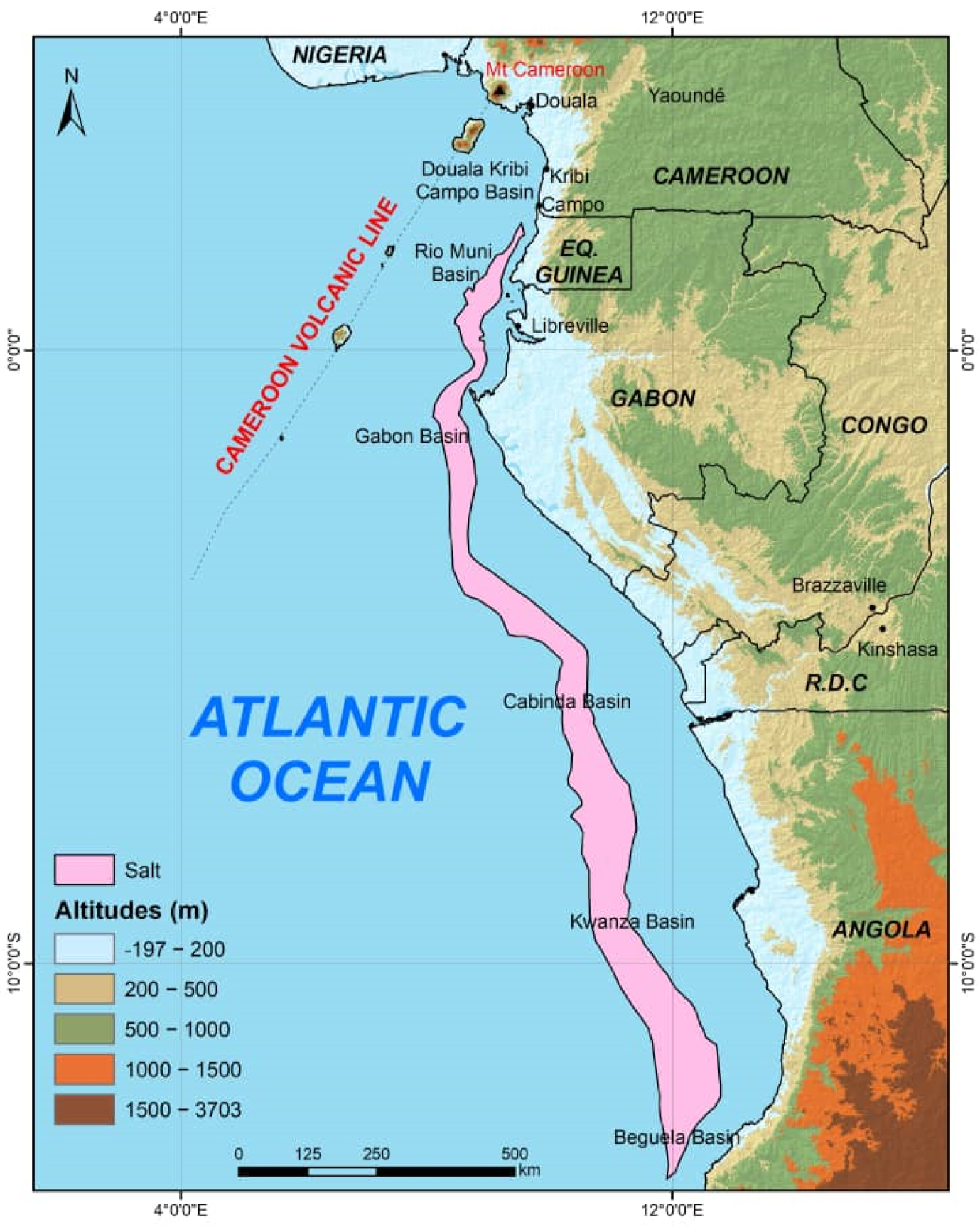
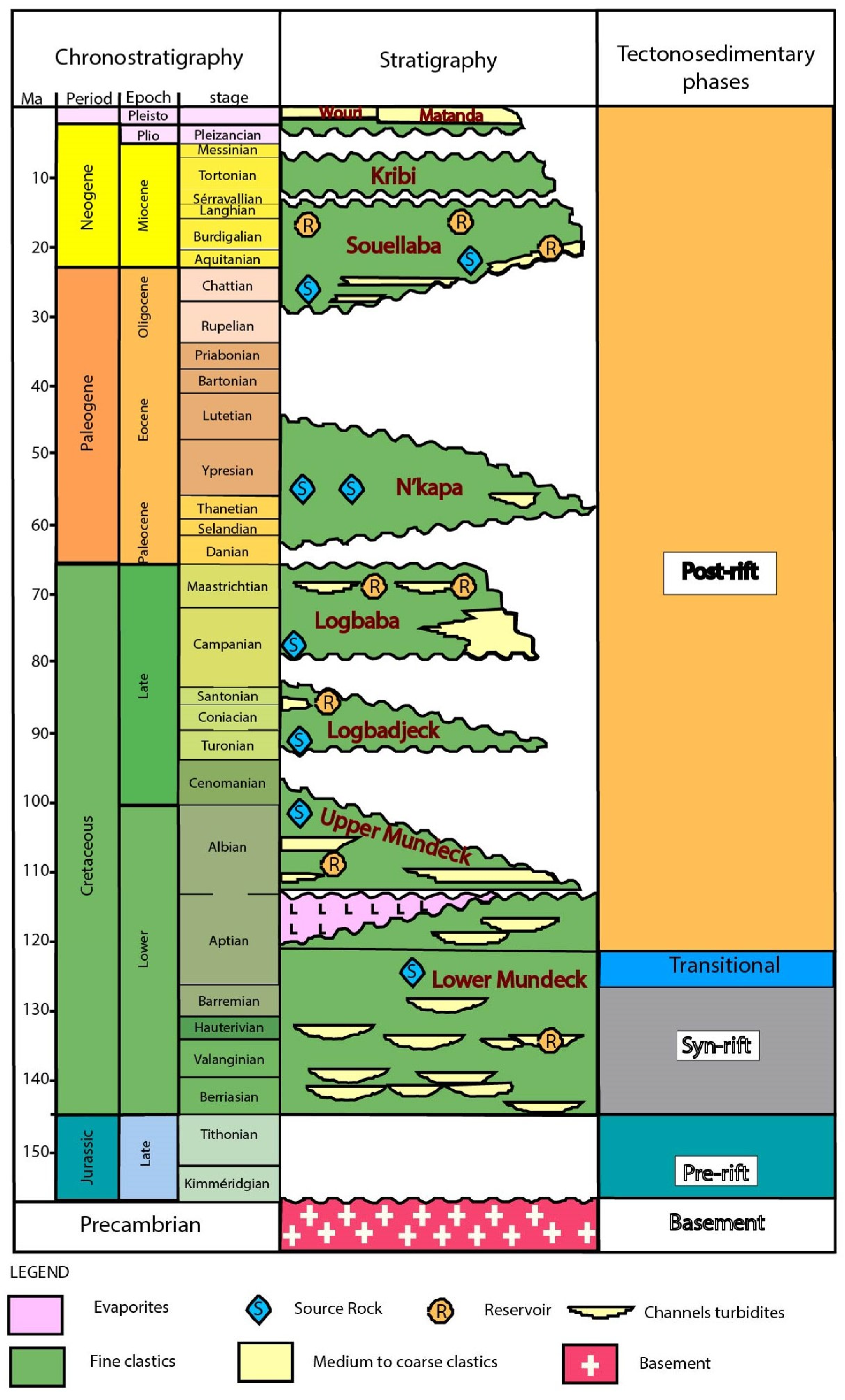
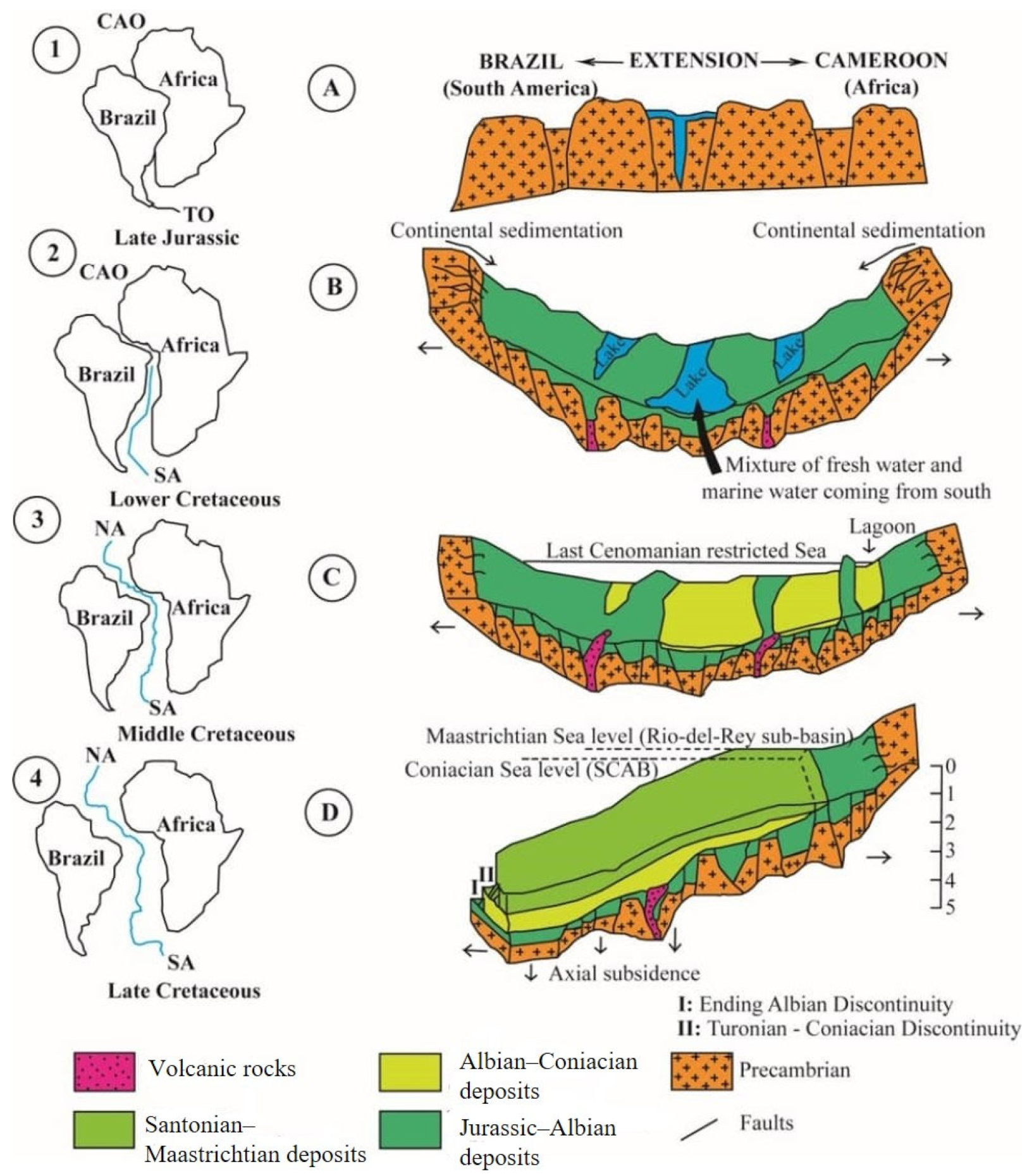
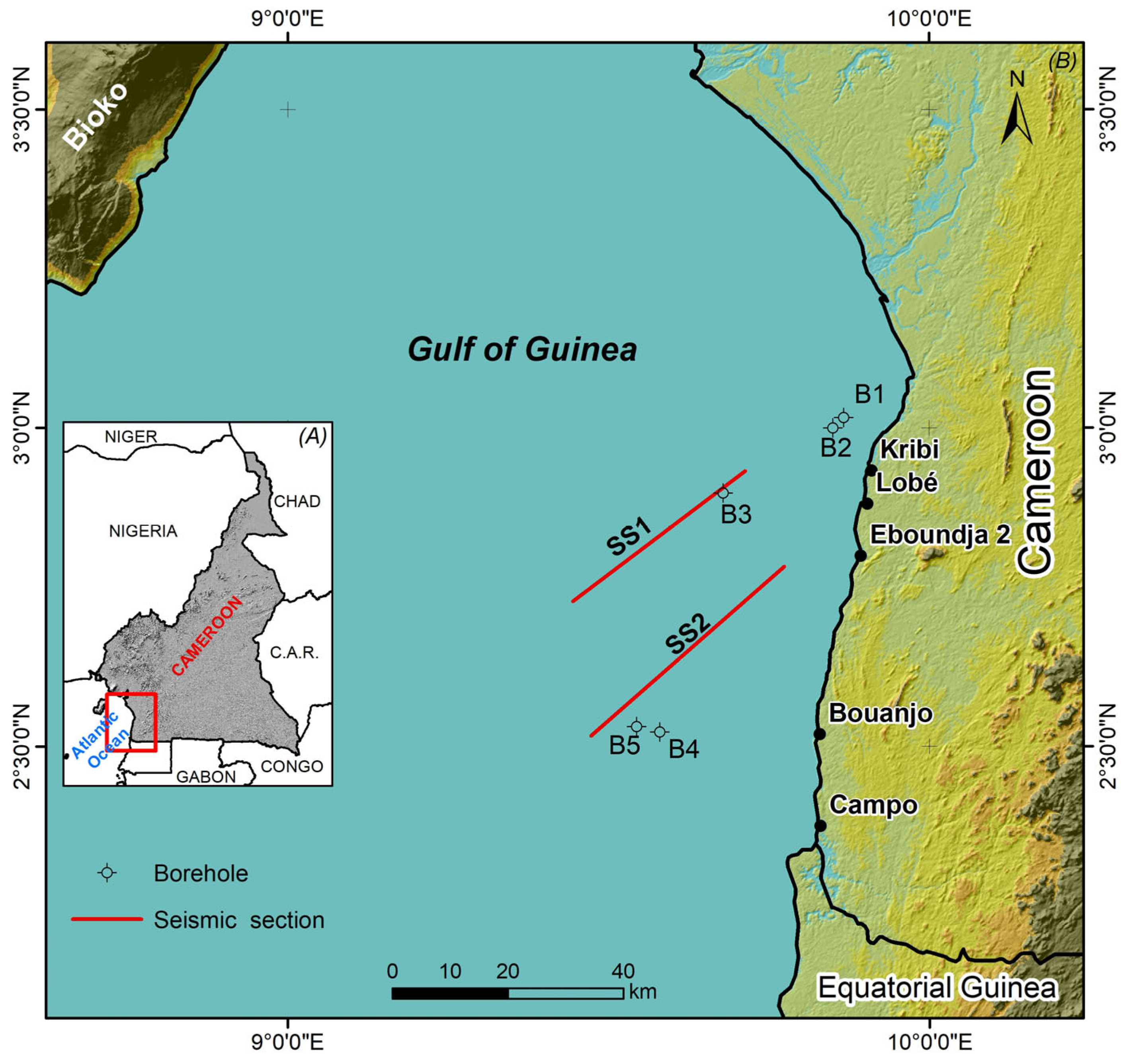

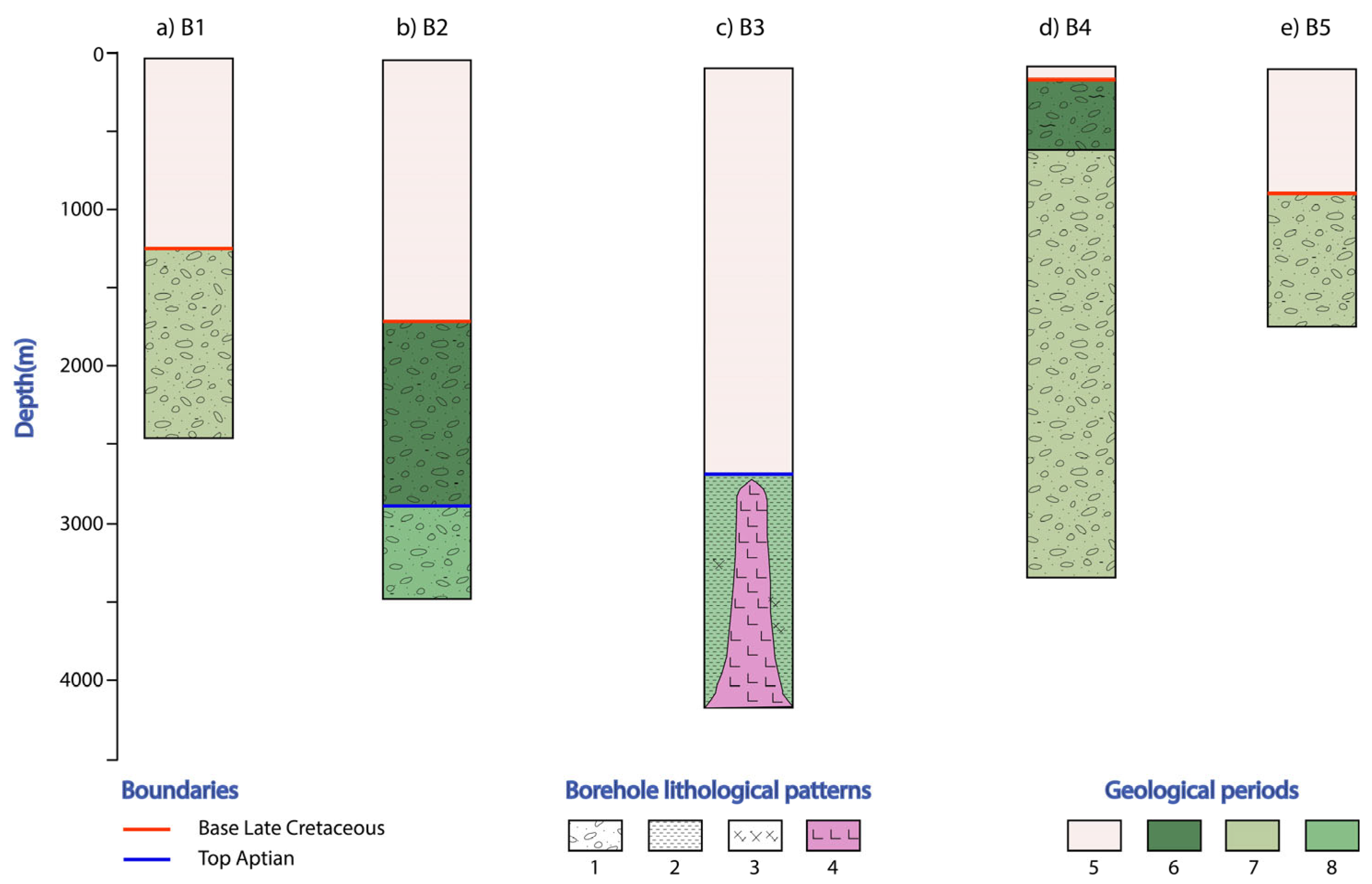

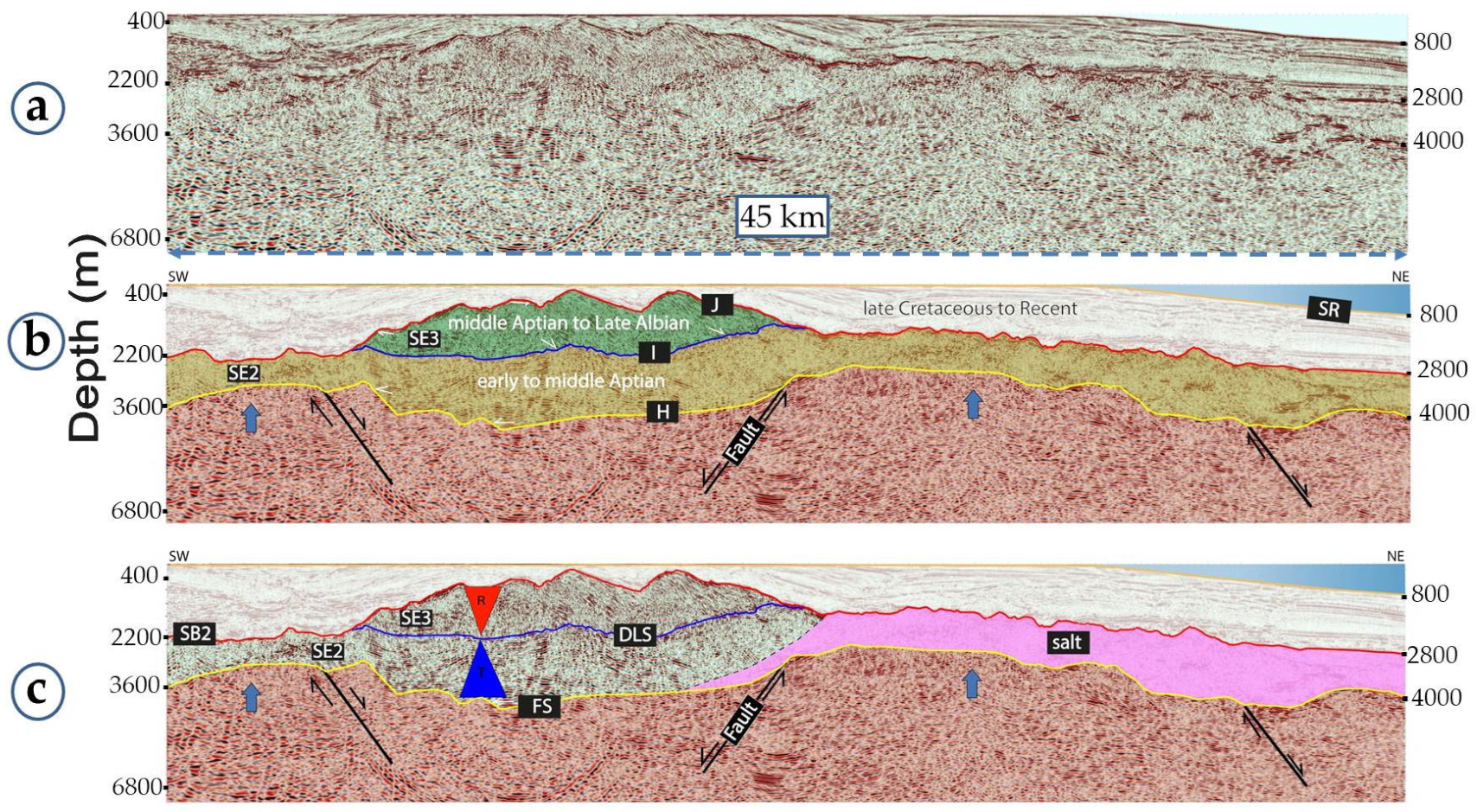
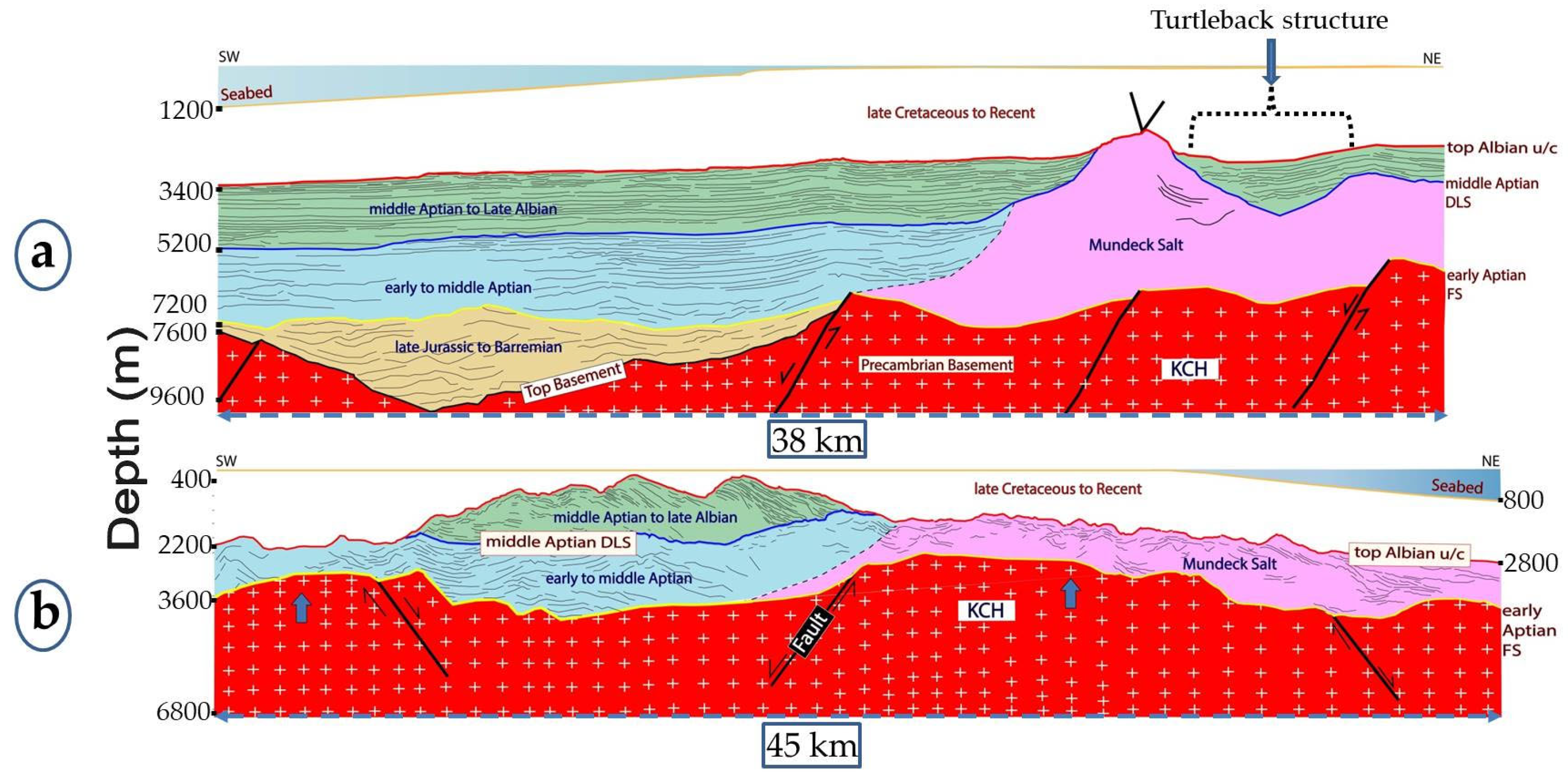

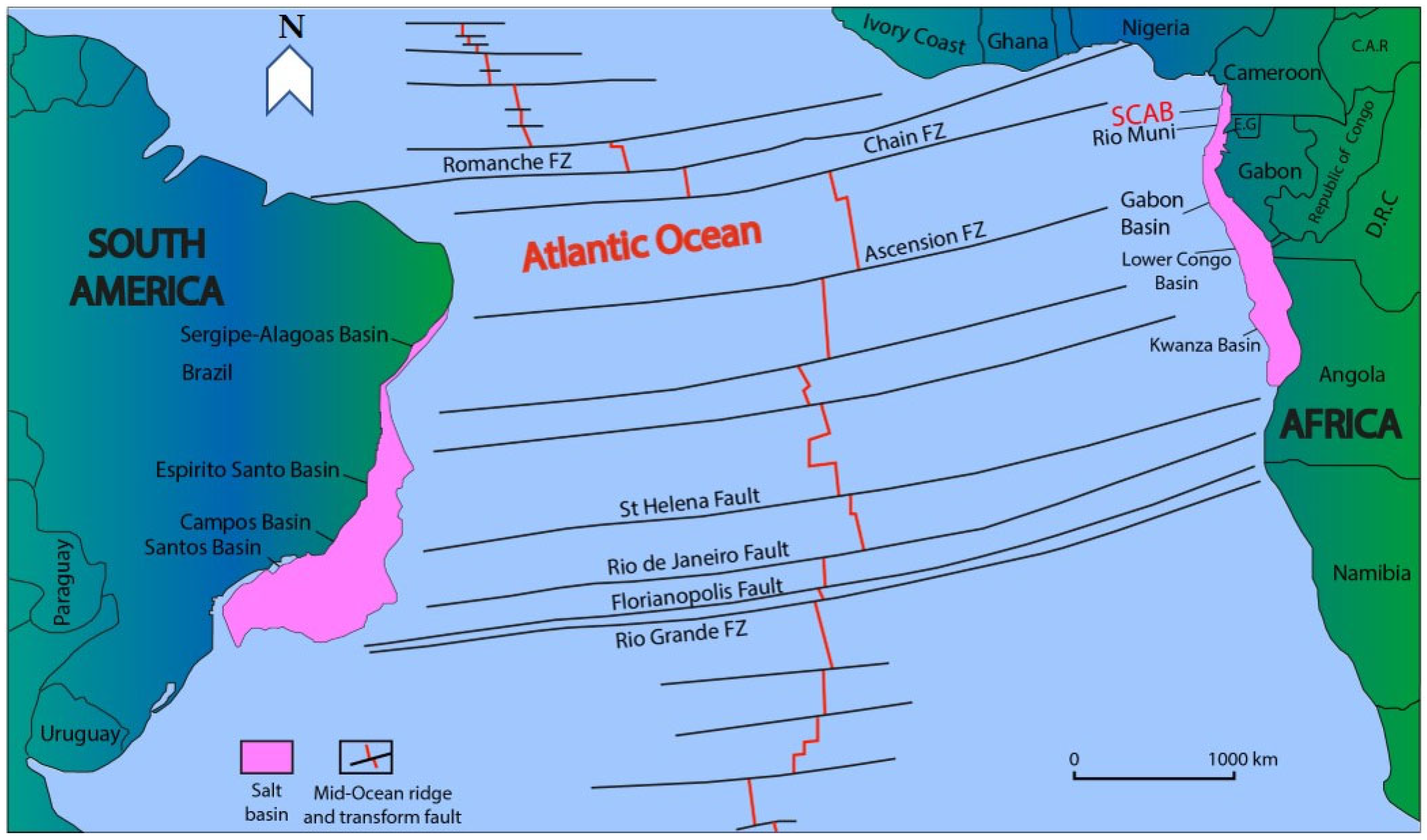
| Borehole | Total Depth (m) | Stratigraphic Interval |
|---|---|---|
| B1 | 2464 | Aptian to Pleistocene |
| B2 | 3475 | Aptian to Pleistocene |
| B3 | 4215 | Aptian to Recent |
| B4 | 3301 | Aptian to Pleistocene |
| B5 | 1750 | Aptian to Pleistocene |
| Characteristic | Value |
|---|---|
| Seismic type | 2D |
| Streamer length | 10,175 m |
| Source volume | 7524 in3 |
| Record length | 18 s |
| Sample rate | 2 ms |
| Fold | 102 |
| Number of channels | 408 |
| Group interval | 25 |
| Shooting interval | 50 |
| streamer depth | 9.5 m |
| Gun depth | 8.5 m |
| Far offset | 10,315 m |
| Near offset | 140 m |
| Seismic Section | Position on the Margin | Direction | Total Length (km) | Total Depth (km) |
|---|---|---|---|---|
| SS1 | Continental shelf to deep basin | NE–SW | 43 | 19.6 |
| SS2 | Continental shelf to deep basin | NE–SW | 28 | 6.8 |
| DHIs Type Tracked | Seismic Characters | Petroleum Significance |
|---|---|---|
| Bright spot | Strong-amplitude reflection caused by large changes in acoustic impedance | Gas-saturated sandstone reservoir underlying a shale interval |
| Flat spot | With dipping reflections, it stands out because of its flat attitude | Well-defined gas/oil or gas/ water contacts |
| Dim spot | Weak-amplitude reflection that reduces the contrast in acoustic impedance | Associated with the occurrence of oil or gas |
Disclaimer/Publisher’s Note: The statements, opinions and data contained in all publications are solely those of the individual author(s) and contributor(s) and not of MDPI and/or the editor(s). MDPI and/or the editor(s) disclaim responsibility for any injury to people or property resulting from any ideas, methods, instructions or products referred to in the content. |
© 2024 by the authors. Licensee MDPI, Basel, Switzerland. This article is an open access article distributed under the terms and conditions of the Creative Commons Attribution (CC BY) license (https://creativecommons.org/licenses/by/4.0/).
Share and Cite
Essi, M.-F.M.; Lee, E.Y.; Yem, M.; Essi, J.M.A.; Atangana, J.Q.Y. The Mundeck Salt Unit: A Review of Aptian Depositional Context and Hydrocarbon Potential in the Kribi-Campo Sub-Basin (South Cameroon Atlantic Basin). Geosciences 2024, 14, 267. https://doi.org/10.3390/geosciences14100267
Essi M-FM, Lee EY, Yem M, Essi JMA, Atangana JQY. The Mundeck Salt Unit: A Review of Aptian Depositional Context and Hydrocarbon Potential in the Kribi-Campo Sub-Basin (South Cameroon Atlantic Basin). Geosciences. 2024; 14(10):267. https://doi.org/10.3390/geosciences14100267
Chicago/Turabian StyleEssi, Mike-Franck Mienlam, Eun Young Lee, Mbida Yem, Jean Marcel Abate Essi, and Joseph Quentin Yene Atangana. 2024. "The Mundeck Salt Unit: A Review of Aptian Depositional Context and Hydrocarbon Potential in the Kribi-Campo Sub-Basin (South Cameroon Atlantic Basin)" Geosciences 14, no. 10: 267. https://doi.org/10.3390/geosciences14100267
APA StyleEssi, M.-F. M., Lee, E. Y., Yem, M., Essi, J. M. A., & Atangana, J. Q. Y. (2024). The Mundeck Salt Unit: A Review of Aptian Depositional Context and Hydrocarbon Potential in the Kribi-Campo Sub-Basin (South Cameroon Atlantic Basin). Geosciences, 14(10), 267. https://doi.org/10.3390/geosciences14100267







